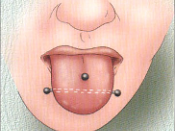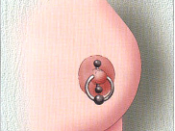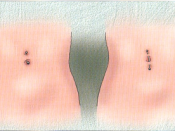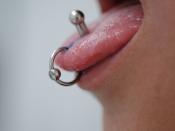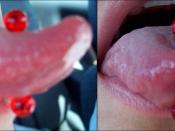�PAGE � Body Piercing Complications �PAGE �1�
Name/School Info Removed
Everyday people get ear, tongue, nipple, navel, and other body piercings without properly
informing themselves. Before anyone goes to get a body piercing they should first conduct research about the many possible complications. People don't often think about the negative aspects of getting a body piercing, but by not knowing about the negative aspects that can
occur one might not be able to properly recognize a problem until it is too late. Medical complications resulting from body piercing procedures and improper aftercare can be vastly reduced through greater education.
Spotting symptoms from minor infections is the key to minimizing complications after a body piercing.
If your piercing is infected, the skin around the area may be red and swollen. It might hurt to
touch your piercing, and there may be yellowish, bad-smelling fluid coming from the hole. If
you have a fever or any of these symptoms, you should see your doctor.
(American Family Physician, 2005)
While minor infections should be taken seriously and treated accordingly there is still a greater threat that comes from major infections.
Unlike minor infections that affect the individual after the body piercing; major infections can be contracted from the procedure itself. Meltzer (2005) states, "Human immunodeficiency virus (HIV), hepatitis B or C, and even tetanus can be contracted from nonsterile piercing techniques. Although earrings may be sterilized before use, most piercings 'guns' are not sterilized between procedures." This can facilitate the spread of infectious viruses from one person to another unknowingly. For this reason it is not recommended to get a body piercing with a piercing "gun."
Choosing a reputable licensed body piercing shop is important to reduce complications associated with the procedure. Each state has strict licensing procedures that body piercers must follow. One should properly research the state regulations in the area the individual plans to obtain the body piercing from. In addition to state licensing many body piercers will take further classes and training improve quality of work and reduce the risk of complications. These additional courses usually include Prevention of Disease Transmission and Blood borne Pathogens, CPR and first aid, human anatomy, and industry created training workshops.
A piercing studio's sterilization program is paramount to reduce the spread of major infections. Any studio that will agree to pierce an individual in the lobby is an establishment that should be avoided. Professional studios will always have separate sterile rooms where the piercing procedure is conducted in. Prior to the receiving the body piercing all items associated with the piercing such as forceps, jewelry, dermal punches, and tubes must sterilized using a steam autoclave. All needles that will be used in the procedure need to be brand new and pre-sterilized. After the procedure is finished the needles must to be disposed of in biohazard bags and disposed of properly and all equipment used must be cleaned again in an autoclave then properly stored in sterile sealed bags.
The most common type of piercing, the ear piercing, has evolved into a plethora of differing possibilities. Though the piercings may appear different in appearance, see Figure 1, they share the same possible medical complications.
Figure 1. Anatomical locations in the ear and types of ear piercings.
Larkin, B. (February 2004). The Ins and Outs of Body Piercing. AORN Journal, 330, 13.
Two of the most common types of complications resulting from piercings of the ear are Auricular Perichondritis and formation of keloids. Auricular Perichondritis presents as painful swelling, warmth, and redness in a portion of the auricle that often spares the earlobe. (Meltzer 2005) Keloids are a type of scar caused from excessive tissue at the location of the healed injury. The formation of keloids can cause severe itchiness, sharp pains, and occasionally inhibit the movement of other skin. There is currently no treatment to remove keloids completely, but there are several avenues to help reduce the appearance and related symptoms.
Typical tongue piercing (Figure 2.) complications are caused by improper jewelry sizes and obstructions of the airway.
Figure 2. Types of tongue piercings.
Larkin, B. (February 2004). The Ins and Outs of Body Piercing. AORN Journal, 330, 13.
When the tongue is pierced, longer jewelry is used to accommodate swelling of the tongue; however, this longer barbell can erode tooth enamel, damage gums, and chip teeth. Replacing the longer barbell is advised as soon as the swelling goes down and to use balls that are non-metal to avoid chipping teeth. Meltzer (2005) warns, "Another serious consequence of oral piercing is compromise of the airway from trauma, tongue swelling, or obstruction by jewelry. Securing an adequate airway or endotracheal intubation can be challenging when a patient has a tongue barbell."
Nipple piercings (Figure 3.) present medical complications such as mastitis, abscesses, and the possible problems breast feeding.
Figure 3. Types of nipple piercings.
Larkin, B. (February 2004). The Ins and Outs of Body Piercing. AORN Journal, 330, 13.
Mastitis is a serious infection of the breast tissue that usually, but not always, affects women. The infection usually starts the milk ducts of the breast after the piercing and symptoms may not appear until the infection has fully developed which can pose serious problems. Abscesses are infections that have been blocked off by the body and are not able to drain properly. These usually form around the outside edge of the piercing and may need to be lanced by a professional to effectively drain the infection and allow the body to heal normally. Meltzer (2005) cautions, the effects of nipple piercings on lactation are not clear, but jewelry or scar tissue could impair latching on or block a milk duct and adversely affect an infant's ability to breastfeed.
Navel piercings (Figure 4.) are the second most popular piercing for women after the ears but they are not without their own share of complications.
Figure 4. Types of navel piercings.
Larkin, B. (February 2004). The Ins and Outs of Body Piercing. AORN Journal, 330, 13.
The most common problems are migration of the piercing and scaring. The navel piercing usually migrates out of the body due to excessive friction cause by the rubbing of the waistband in clothing. The piercing may also migrate out of the body due to abdominal growth during a pregnancy. Scarring can also be an issue when the piercing is removed. The use of vitamin E can help alleviate the appearances of scars after the jewelry has been removed.
Proper aftercare is the biggest thing an individual can do to prevent the early onset of infection after receiving a body piercing. Cleaning the piercing is vital and knowing how to do it properly is important. Association of Professional Piercers (2004) recommends these guidelines:
WASH your hands thoroughly prior to cleaning, or touching on or near your piercing for any reason. 2) SALINE soak at least two to three times daily. Simply invert a cup of warm saline solution over the area to form a vacuum for a few minutes. The longer you soak, the better. For certain placements it may be easier to apply using fresh gauze or a cotton ball saturated with saline solution. A brief rinse will remove any residue. 3) SOAP no more than once or twice a day. While showering, lather up a pearl size drop of the soap to clean the jewelry and the piercing. Leave the cleanser on the piercing no more than thirty seconds, then rinse thoroughly to remove all traces of the soap from the piercing. 4) DRY with disposable paper products such as gauze or tissues, because cloth towels can harbor bacteria and catch on new piercings causing injury. Pat gently to avoid trauma.
Having a follow-up appointment with the piercer who did the procedure is highly recommended. While in the appointment is always best to have the piercer change out the jewelry for the first time to make sure it is done correctly and to provide tips on how to change the jewelry properly. The piercer has vast amounts of experience with aftercare and will know what proper healing should look like. If there are any questions during the healing period or anything unusual happens with the piercing the piercer should be notified right away. The piercer will be able to provide guidance on what should be done next.
The next time you consider getting a body piercing; remember there is more to think about than just where you want to get pierced. Make sure to educate yourself about the piercing placement, jewelry being used, piercer doing the work, and the aftercare involved. Each piercing has its own special set of complications so make sure to research carefully to avoid possibly complications. Keeping these things in mind can greatly reduce medical complications that may arise from the procedures.
References
American Family Physician (2005). Body piercing: what you should know.
72, 10. P.1. Retrieved January 28, 2008, from General OneFile via Gale:
http://find.galegroup.com/ips/start.do?prodId=IPS
Association of Professional Piercers (2004). Body & Facial Piercing Aftercare
Guidelines Retrieved January 31, 2008, from
http://www.safepiercing.org/bodyAftercare.html
Larkin, B. (2004). The ins and outs of body piercing. AORN Journal, 79, 2. p.330
Retrieved January 28, 2008, from General OneFile via Gale:
http://find.galegroup.com/ips/start.do?prodId=IPS
Meltzer, D. (2005). Complications of body piercing. American Family Physician,
72(10), 2029. Retrieved January 12, 2008, from General OneFile via Gale:
http://find.galegroup.com/ips/start.do?prodId=IPS

